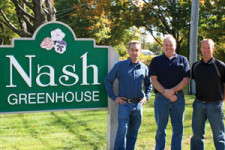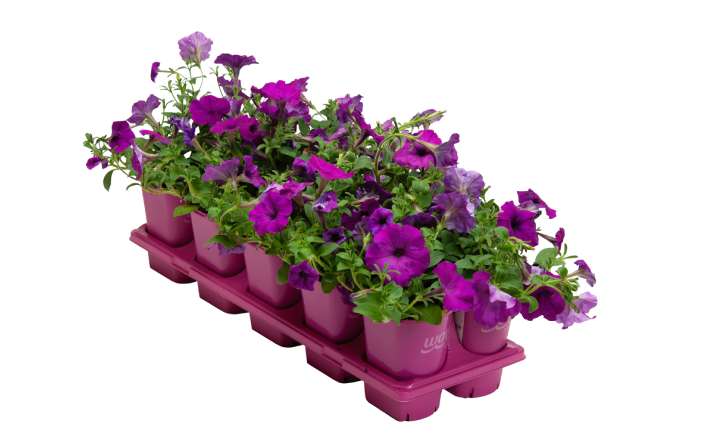Nash Greenhouse: Learning On The Fly

Howard Nash didn’t grow up in a family greenhouse business like so many others have. And the first industries in which he worked–electronics and medical transcriptions–had little to do with greenhouse floriculture.
But it’s Nash’s other experiences, as well as his son Mark’s, that make Nash Greenhouse unique. The father-and-son team jumped cold turkey into the industry when it purchased the Kalamazoo operation formerly known as Dick’s Greenhouse in 2003. Back then, the Nash family was working with 8 ½ acres of production space. But in the seven years since, the operation has expanded to nearly 25 acres considering all the plant material that ultimately flows through Nash Greenhouse.
“Our investment is going great,” Howard says. “We’ve had growth. We’ve been very blessed. We have taken a different approach than a lot of other people, too. We like to be a little more diversified. We don’t have all our eggs in one basket. We’re working with a lot of different brokers, we broker a lot of material ourselves and we have a lot of different customers.”
New Beginning
Nash Greenhouse didn’t land those customers overnight, though. Before the father-and-son team purchased the operation, Howard spent a year working for the previous owner learning the business and hammering out details for the transition. The year Howard spent working for the previous owner also gave Mark, whose background is accounting and finance, the chance to determine whether a purchase made sense.
“There were some changes the previous owner let me make immediately,” Howard says. “I was able to cut quite a bit of payroll, and we actually saved him some money that year. The first year here we added some shade cloth in certain areas–he had no shade cloth except in one glass house–and we took out nine heaters.”
Still, because the Nashes had no greenhouse floriculture experience, it was important they find and add people who could help in areas like production, sales and marketing.
Fortunately, one of Mark’s childhood friends, Chad Earles, was a grower and looking for a job at the time the Nashes made their investment. And Dan Triemstra, another grower Howard knew through a broker, came aboard after closing his own business.
Ric Stevens, director of sales and marketing, is another key player at Nash Greenhouse. He joined the operation in 2006 and helped diversify it with new crops and customers.”Because Mark and I didn’t know the industry, it was our job to find the best people and rely on their expertise,” Howard says. “We let those people have a lot of input. When we make big decisions, we get the input from our growers. Even our salespeople are involved in them. We want their input to make sure we’re all on the same page.”
Stevens, for one, appreciates Howard’s and Mark’s open approach.
“I knew these two were really good business guys,” says Stevens, who previously worked for the Kalamazoo Flower Group. “I actually approached them with an idea because I knew they had all of their eggs in one basket.
“I had a pretty good feel for what was going on in the industry at the time. Consolidation was starting to happen. I could see a lot of these operations growing so many items, and it’s so much easier when you grow fewer items and more of them. You create a lot of efficiencies that way.”
Now, spring production is largely Wave petunias. Fall mums are also grown at Nash Greenhouse, but poinsettias and Christmas crops are items the operation avoids.
“You’ve got to have a good base to start,” Mark says. “If you’re starting out in the hole or making negative margin, why even put the effort into it? We kind of tried that one time, when we thought we were going to gain efficiencies by doing big bulk runs of material. From the start, I knew we were barely making any margin.”
There are times, of course, when Nash Greenhouse will take less margin to help a customer in a single instance or add value to a customer relationship. There is, however, a fine line between taking less margin on crops once and taking less margin regularly.
“If, for example, we’re growing Waves for a greenhouse and they also want us to do a premium program, I could take less margin on it if it’s a breaking point,” Mark says. “Then, I’m helping a customer but also hitting my sweet spot with the Waves.”
Continuous Reinvestment
Much of the material Nash Greenhouse grows–Waves included–is produced for large operations serving the box stores. The Nashes, of course, are aware those operations could add greenhouse space at any time and eliminate a chunk of their business. But as long as Nash Greenhouse continues to provide quality plants and outstanding service, the Nashes believe contract growing makes sense for them.
“We cleared a lot of property to add on and we’ve done a lot of looking at greenhouse structures,” Mark says. “But we have to decide how big is too big and how big we want to become. Or, is it better to buy an existing facility?”
For the time being, Nash’s “Heinz 57” greenhouse facility will have to do.
“We have wooden ranges that were hand made–Van Wingerdens, Rough (Brothers), Westbrook (Greenhouse Systems) greenhouses and old A-frames,” Mark says. “One of our goals is to eventually take the A-frames down so we can put in shade curtains, floor heat, booms and other technologies where we want them.”
Perhaps the biggest change Nash Greenhouse has made in its eight years is to widen a middle aisle so material can more easily be moved from greenhouses to loading docks. The aisle also serves as a facility midpoint where new greenhouses can be built in the place of old ones on each side.
“You have to continually invest in the business, and something as simple as making aisles wider is just that,” Stevens says. “Before, we had multiple orders getting loaded at one time and, obviously, we need more docks. But now we can better utilize the docks we do have. Even scheduling trucks is easier now.”
Nash Greenhouse still has more work to do, but the plan is to continually reinvest assuming sales growth continues.
As for Howard’s and Mark’s futures: Greenhouse floriculture is most likely the last industry in which Howard will work, and Mark plans to be involved in coming years but perhaps at a lesser extent.
“For me, I look at this as a business investment that, down the road, I hope others can handle more of the day-to-day operations,” Mark says. “I’ve got three young kids, and they love coming down here. If they want to take over someday, this is something that would be here for them. But it’s a double-edged sword for me: How long do I stick around, and do I keep it in the family? You’ve got to be smart about it.”









